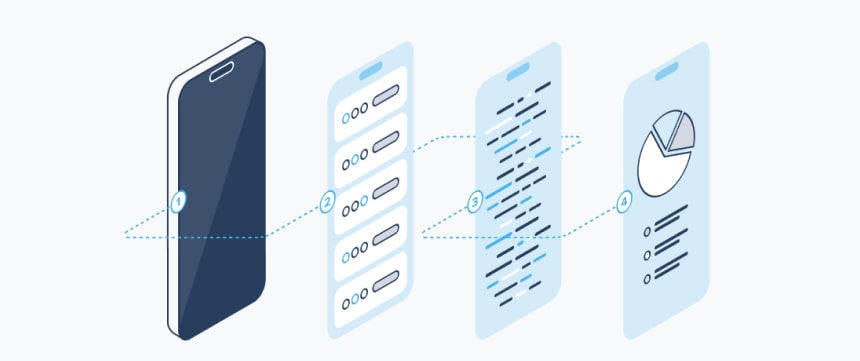
A Guide To Mobile App Architecture
Constructing a successful and user-friendly application extends beyond mere coding; it necessitates meticulous planning, strategic design, and a sturdy architectural foundation. Mobile app architecture serves as the skeletal framework for the entire application, delineating its structure, functionality, and interactions. This article aims to explore into the intricate components of mobile app architecture and explore best practices for erecting scalable, maintainable, and high-performance applications.
Understanding Mobile App Architecture

Mobile app architecture is the structural blueprint of an application, encompassing its myriad layers, components, and technologies. A well-crafted architecture not only ensures the seamless operation of the app but also facilitates future enhancements and updates. Various architectural patterns are prevalent in mobile app development, each boasting distinct advantages and trade-offs. Let’s explore some of the popular architectural patterns:
1. Model-View-Controller (MVC)
MVC, one of the oldest architectural patterns, is widely employed in mobile app development. It partitions the application into three interconnected components:
Model: Encompasses the data and business logic of the application.
View: Presents the user interface to the user.
Controller: Manages user input and orchestrates updates to the model and view accordingly.
2. Model-View-View Model (MVVM)
MVVM, a contemporary iteration of MVC, finds extensive usage in modern mobile app development, especially with frameworks like React Native and Flutter. It introduces a ViewModel layer, serving as an intermediary between the view and the model, thus facilitating improved separation of concerns and enhanced testability.
3. Clean Architecture
Clean Architecture, conceptualized by Robert C. Martin, advocates for the segregation of concerns and the autonomy of layers within an application. It comprises several layers, including the presentation layer, domain layer, and data layer, each endowed with distinct responsibilities and dependencies. Clean Architecture fosters testability, maintainability, and scalability.
Key Components of Mobile App Architecture

Irrespective of the chosen architectural pattern, mobile app architecture typically incorporates the following pivotal components:
1. User Interface (UI) Layer
The User Interface (UI) layer serves as the gateway between the user and the application's functionality. It encompasses various components responsible for presenting information to the user and facilitating interactions. Within the UI layer, developers design screens, views, and widgets, crafting the visual and interactive elements of the app. Additionally, this layer encompasses navigation logic, determining how users traverse through different screens and sections of the application.
Key Components:
Screens and Views: Screens represent individual sections or views within the app, while views encapsulate specific UI elements such as buttons, text fields, and images.
Widgets and Controls: Widgets are reusable UI components that can be dynamically updated based on user input or application state. Controls, such as buttons and sliders, enable user interactions and actions.
Layout Management: Layout management involves arranging UI components on the screen in a visually appealing and intuitive manner, ensuring consistency across different devices and screen sizes.
Navigation: Navigation logic dictates how users navigate between different screens and sections of the application, encompassing features like tab bars, side menus, and navigation drawers.
2. Business Logic Layer
The Business Logic Layer contains the core functionality and rules governing the application's operations. It encapsulates the business logic, data processing, and validation rules that define how the application behaves and responds to user actions. This layer abstracts away the complexities of data manipulation and computation, ensuring that the application's behavior remains consistent and predictable across various scenarios.
Key Components:
Data Processing: Data processing involves manipulating and transforming raw data into meaningful information that can be presented to the user. This may include calculations, data aggregation, filtering, and sorting operations.
Business Rules: Business rules define the logic and constraints governing how the application operates. These rules dictate permissible actions, validation criteria, and business workflows.
State Management: State management involves managing the state of the application, including user input, application state, and data changes. It ensures that the application remains responsive and maintains data integrity throughout its lifecycle.
3. Data Layer
The Data Layer is responsible for managing data storage, retrieval, and synchronization within the application. It encompasses components that interact with external data sources, such as databases, web services, and APIs, to fetch and persist data. Additionally, the Data Layer includes mechanisms for caching data locally, optimizing data access, and ensuring data consistency and reliability.
Key Components:
Data Models: Data models represent the structure and schema of the application's data entities, defining how data is organized and represented within the application.
Data Access Components: Data access components interact with external data sources to fetch, store, and manipulate data. This may involve making HTTP requests to web services, querying databases, or interacting with third-party APIs.
Caching and Local Storage: Caching mechanisms store frequently accessed data locally to improve performance and reduce network latency. Local storage mechanisms, such as SharedPreferences or CoreData, enable persistent storage of data on the device.
Data Synchronization: Data synchronization mechanisms ensure that data remains consistent across different devices and platforms. This may involve periodic synchronization with a server, conflict resolution, and handling offline data scenarios.
4. Communication Layer
The Communication Layer facilitates communication between the mobile app and external services or servers. It encompasses components responsible for making network requests, handling responses, and managing network connectivity. Additionally, the Communication Layer addresses aspects such as authentication, authorization, and data encryption to ensure secure and reliable communication with external services.
Key Components:
Network Request Handling: Network request handling involves making HTTP requests to external services or servers to fetch or submit data. This may include fetching data from a RESTful API, submitting form data, or downloading files.
Response Handling: Response handling involves processing responses received from external services, parsing data formats such as JSON or XML, and extracting relevant information for further processing or display.
Network Connectivity Management: Network connectivity management ensures that the application remains responsive and functional across different network conditions. This may involve monitoring network status, handling network errors, and implementing retry mechanisms.
Authentication and Authorization: Authentication and authorization mechanisms authenticate users and grant access to protected resources. This may involve user login, session management, token-based authentication, and role-based access control.
Data Encryption and Security: Data encryption and security mechanisms encrypt sensitive data transmitted over the network to protect it from unauthorized access or interception. This may involve using secure communication protocols such as HTTPS and implementing encryption algorithms to secure data at rest and in transit.
Best Practices for Mobile App Architecture

Constructing a robust and scalable mobile app architecture mandates adherence to best practices and design principles. Here are some cardinal guidelines to bear in mind:
Separation of Concerns: Partition your application into distinct layers with well-defined responsibilities, such as UI, business logic, and data management.
Modularity: Design your application in a modular fashion, fostering reusable components and transparent dependencies between modules.
Scalability: Anticipate scalability considerations from the outset, encompassing factors like user expansion, data volume, and performance exigencies.
Testability: Proliferate unit tests, integration tests, and UI tests to ascertain the reliability and correctness of your application.
Flexibility: Craft your architecture to accommodate prospective changes and enhancements, including new features or platform updates.
Performance Optimization: Implement optimization strategies like lazy loading, caching, and background processing to amplify app performance and responsiveness.
Mobile app architecture assumes a pivotal role in determining the triumph of a mobile application. By adhering to best practices and design principles, developers can conceive robust, scalable, and maintainable architectures, furnishing users with seamless digital experiences. Whether embarking on the construction of a petite prototype or a labyrinthine enterprise app, dedicating time and effort to architecting the right framework will yield dividends in the long haul, ensuring the longevity and triumph of your mobile application.
Established in 2013, Royex Technologies is a leading mobile app development company in Dubai, that provides innovative solutions for small, medium, and large-scale companies. We specialize in responsive web development, mobile app development, CRM integration, AI solutions for website & mobile applications, and many more. Our extensive experience in mobile app development will help you to take your business to a high level.
Check our portfolio to see our previous works. Contact us via email at info@royex.net or call us at +971566027916 to get started with us.




